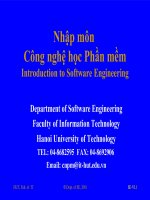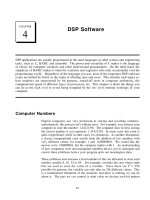Software cost estimation
Bạn đang xem bản rút gọn của tài liệu. Xem và tải ngay bản đầy đủ của tài liệu tại đây (118.36 KB, 20 trang )
©Ian Sommerville 2004 Software Engineering, 7th edition. Chapter 26 Slide 1
Software cost estimation
©Ian Sommerville 2004 Software Engineering, 7th edition. Chapter 26 Slide 2
Objectives
To introduce the fundamentals of software
costing and pricing
To describe three metrics for software
productivity assessment
To explain why different techniques should
be used for software estimation
To describe the principles of the COCOMO 2
algorithmic cost estimation model
©Ian Sommerville 2004 Software Engineering, 7th edition. Chapter 26 Slide 3
Topics covered
Software productivity
Estimation techniques
Algorithmic cost modelling
Project duration and staffing
©Ian Sommerville 2004 Software Engineering, 7th edition. Chapter 26 Slide 4
Fundamental estimation questions
How much effort is required to complete an
activity?
How much calendar time is needed to
complete an activity?
What is the total cost of an activity?
Project estimation and scheduling are
interleaved management activities.
©Ian Sommerville 2004 Software Engineering, 7th edition. Chapter 26 Slide 5
Software cost components
Hardware and software costs.
Travel and training costs.
Effort costs (the dominant factor in most
projects)
• The salaries of engineers involved in the project;
• Social and insurance costs.
Effort costs must take overheads into account
• Costs of building, heating, lighting.
• Costs of networking and communications.
• Costs of shared facilities (e.g library, staff restaurant,
etc.).
©Ian Sommerville 2004 Software Engineering, 7th edition. Chapter 26 Slide 6
Costing and pricing
Estimates are made to discover the cost, to
the developer, of producing a software
system.
There is not a simple relationship between
the development cost and the price charged
to the customer.
Broader organisational, economic, political
and business considerations influence the
price charged.
©Ian Sommerville 2004 Software Engineering, 7th edition. Chapter 26 Slide 7
Software pricing factors
Market
opportunity
A development organisation may quote a low price because it
wishes to move into a new segment of the software market.
Accepting a low profit on one project may give the opportunity
of more profit later. The experience gained may allow new
products to be developed.
Cost estimate
uncertainty
If an organisation is unsure of its cost estimate, it may increase
its price by some contingency over and above its normal profit.
Contractual terms A c ustomer may be willing to allow the developer to retain
ownership of the source code and reuse it in other projects. The
price charged may then be less than if the software source code
is handed over to the customer.
Requirements
volatility
If the requirements are likely to change, an organisation may
lower its price to win a contract. After the contract is awarded,
high prices can be charged for changes to the requirements.
Financial health Developers in financial difficulty may lower their price to ga in
a contract. It is better to make a smaller than normal profit or
break even than to go out of business.
©Ian Sommerville 2004 Software Engineering, 7th edition. Chapter 26 Slide 8
A measure of the rate at which individual
engineers involved in software development
produce software and associated
documentation.
Not quality-oriented although quality
assurance is a factor in productivity
assessment.
Essentially, we want to measure useful
functionality produced per time unit.
Software productivity
©Ian Sommerville 2004 Software Engineering, 7th edition. Chapter 26 Slide 9
Size related measures based on some
output from the software process. This may
be lines of delivered source code, object
code instructions, etc.
Function-related measures based on an
estimate of the functionality of the delivered
software. Function-points are the best known
of this type of measure.
Productivity measures
©Ian Sommerville 2004 Software Engineering, 7th edition. Chapter 26 Slide 10
Estimating the size of the measure (e.g. how
many function points).
Estimating the total number of programmer
months that have elapsed.
Estimating contractor productivity (e.g.
documentation team) and incorporating this
estimate in overall estimate.
Measurement problems
©Ian Sommerville 2004 Software Engineering, 7th edition. Chapter 26 Slide 11
What's a line of code?
• The measure was first proposed when programs were
typed on cards with one line per card;
• How does this correspond to statements as in Java which
can span several lines or where there can be several
statements on one line.
What programs should be counted as part of the
system?
This model assumes that there is a linear
relationship between system size and volume of
documentation.
Lines of code
©Ian Sommerville 2004 Software Engineering, 7th edition. Chapter 26 Slide 12
The lower level the language, the more
productive the programmer
• The same functionality takes more code to implement in a
lower-level language than in a high-level language.
The more verbose the programmer, the higher
the productivity
• Measures of productivity based on lines of code suggest
that programmers who write verbose code are more
productive than programmers who write compact code.
Productivity comparisons
©Ian Sommerville 2004 Software Engineering, 7th edition. Chapter 26 Slide 13
System development times
Analysis Design Coding Testing Documentation
Assemblycode
High-level language
3 weeks
3 weeks
5 weeks
5 weeks
8 weeks
4 weeks
10
weeks
6 weeks
2 weeks
2 weeks
Size Effort Productivity
Assemblycode
High-level language
5000 lines
1500 lines
28 weeks
20 weeks
714 lines/month
300 lines/month
©Ian Sommerville 2004 Software Engineering, 7th edition. Chapter 26 Slide 14
Function points
Based on a combination of program characteristics
• external inputs and outputs;
• user interactions;
• external interfaces;
• files used by the system.
A weight is associated with each of these and the
function point count is computed by multiplying each
raw count by the weight and summing all values.
UFC=(number ofelementsofgiventype)(weight)
©Ian Sommerville 2004 Software Engineering, 7th edition. Chapter 26 Slide 15
Function points
The function point count is modified by complexity of
the project
FPs can be used to estimate LOC depending on the
average number of LOC per FP for a given language
• LOC = AVC * number of function points;
• AVC is a language-dependent factor varying from 200-
300 for assemble language to 2-40 for a 4GL;
FPs are very subjective. They depend on the
estimator
• Automatic function-point counting is impossible.
©Ian Sommerville 2004 Software Engineering, 7th edition. Chapter 26 Slide 16
Object points
Object points (alternatively named application
points) are an alternative function-related measure
to function points when 4Gls or similar languages
are used for development.
Object points are NOT the same as object classes.
The number of object points in a program is a
weighted estimate of
• The number of separate screens that are displayed;
• The number of reports that are produced by the system;
• The number of program modules that must be developed
to supplement the database code;
©Ian Sommerville 2004 Software Engineering, 7th edition. Chapter 26 Slide 17
Object point estimation
Object points are easier to estimate from a
specification than function points as they are
simply concerned with screens, reports and
programming language modules.
They can therefore be estimated at a fairly
early point in the development process.
At this stage, it is very difficult to estimate
the number of lines of code in a system.
©Ian Sommerville 2004 Software Engineering, 7th edition. Chapter 26 Slide 18
Real-time embedded systems, 40-160
LOC/P-month.
Systems programs , 150-400 LOC/P-month.
Commercial applications, 200-900
LOC/P-month.
In object points, productivity has been
measured between 4 and 50 object
points/month depending on tool support and
developer capability.
Productivity estimates
©Ian Sommerville 2004 Software Engineering, 7th edition. Chapter 26 Slide 19
Factors affecting productivity
Application
domain
experience
Knowledge of the application domain is essential for effective
software development. Engineers who already understand a
domain are likely to be the most productive.
Process quality The development process used can have a s ignificant effect on
productivity. This is covered in Chapter 28.
Project size The larger a project, the more time required for team
communications. Less time is available for development so
individual productivity is reduced.
Technology
support
Good support technology such as C ASE tools, configuration
management systems, etc. can improve productivity.
Working
environment
As I discussed in Chapter 25, a quiet working environment with
private work areas contributes to improved productivity.
©Ian Sommerville 2004 Software Engineering, 7th edition. Chapter 26 Slide 20
All metrics based on volume/unit time are
flawed because they do not take quality into
account.
Productivity may generally be increased at the
cost of quality.
It is not clear how productivity/quality metrics
are related.
If requirements are constantly changing then an
approach based on counting lines of code is not
meaningful as the program itself is not static;
Quality and productivity
©Ian Sommerville 2004 Software Engineering, 7th edition. Chapter 26 Slide 21
Estimation techniques
There is no simple way to make an accurate
estimate of the effort required to develop a software
system
• Initial estimates are based on inadequate information in a
user requirements definition;
• The software may run on unfamiliar computers or use
new technology;
• The people in the project may be unknown.
Project cost estimates may be self-fulfilling
• The estimate defines the budget and the product is
adjusted to meet the budget.
©Ian Sommerville 2004 Software Engineering, 7th edition. Chapter 26 Slide 22
Changing technologies
Changing technologies may mean that previous
estimating experience does not carry over to new
systems
• Distributed object systems rather than mainframe
systems;
• Use of web services;
• Use of ERP or database-centred systems;
• Use of off-the-shelf software;
• Development for and with reuse;
• Development using scripting languages;
• The use of CASE tools and program generators.
©Ian Sommerville 2004 Software Engineering, 7th edition. Chapter 26 Slide 23
Estimation techniques
Algorithmic cost modelling.
Expert judgement.
Estimation by analogy.
Parkinson's Law.
Pricing to win.
©Ian Sommerville 2004 Software Engineering, 7th edition. Chapter 26 Slide 24
Estimation techniques
Algorithmic
cost modelling
A model based on historical cost information that relates some software
metric (usually its size) to the project cost is used. An estimate is made
of that metric and the model predicts the effort required.
Expert
judgement
Several experts on the proposed software development techniques and
the application domain are consulted. They each estimate the project
cost. These estimates are compared and discussed. The estimation
process iterates until an agreed estimate is reached.
Estimation by
analogy
This technique is applicable when other projects in the same application
domain have been completed. The cost of a new project is estimated by
analogy with these completed projects. Myers (Myers 1989) gives a
very clear description of this approach.
ParkinsonÕs
Law
ParkinsonÕsLaw states that work expands to fill the time available. The
cost is determined by available resources rather than by objective
assessment. If the software has to be delivered in 12 months and 5
people are available, the effort required is estimated to be 60 person-
months.
Pricing to win The software cost is estimated to be whatever the customer has
available to spend on the project. The estimated effort depends on the
customerÕs budget and not on the software functionality.









